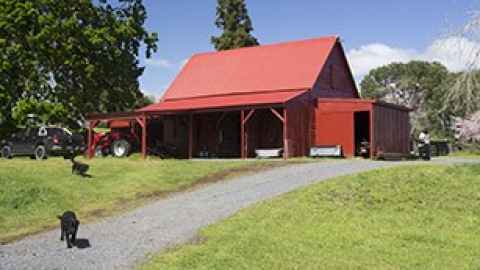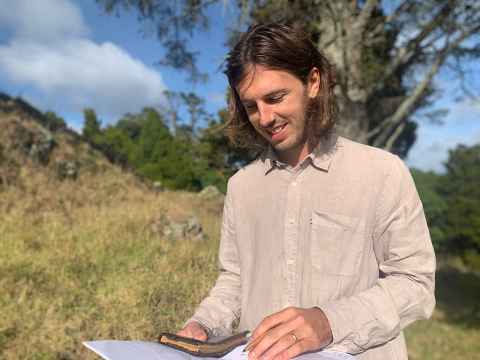It looks like a barn but likely the fifth oldest European building in the country
27 July 2020
A building generally perceived and described as a Northland Barn could be the fifth oldest European building in the country, along with some of the most famous landmarks in the region including Kemp House, the Stone Store, Te Waimate Mission and the Treaty House.

This is according to the investigations of Daniel Cowley who did a report on the building as a thesis research project for his Master of Architecture (Professional) and Heritage Conservation at the School of Architecture and Planning, submitted this year.
As he discovered, the building, the ‘Pouerua Store/Stable’ is “one of the earliest remaining examples of European architecture in New Zealand, and quite likely the fifth oldest.”
It can be traced back to missionary Henry Williams who bought property in Pākaraka as a sheep and cattle station in 1835 and moved there with his six sons.
Daniel’s investigations (conducted over a period of three months in 2019) revealed compelling evidence that what became known as a barn was initially constructed as “a Colonial Georgian style one-and-a-half storeyed residence and ‘balloon frame’ structure, a precursor to what morphed into the Victorian-style villa,” says Daniel.
While by 1850 the Williams had moved out of the building, the ‘barn’ was then used to hold church services while the Holy Trinity Anglican Church at Pākaraka was being built.
By 2019, the building was dilapidated but proved to be remarkably resilient, and Daniel’s investigations revealed a level of care and detail in the structure, design and construction that convinced him it was originally built as a residence.
Pouerua Store/Stable is “one of the earliest remaining examples of European architecture in New Zealand, and quite likely the fifth oldest.”

It shows the use of native New Zealand timber, including totara, pūriri and kauri, and of early European construction and techniques used in other early buildings of the 1830s, such as pit-sawn timber and hand-planed tongue and groove joinery, Georgian-style windows, evidence of pre-existing shutters and detailed parliament hinges made of cast iron and single stays.
“It’s quite possible that the Williams bought with them skilled carpenters who had built the mission houses at Paihia in 1830, both Māori and Pākehā, but also likely the sons were assisted by local Māori to build the home.”
The devil is often found in the concealed details. “When I put my hand above the upper floor, reaching to feel the internal stud, I felt more of a groove, and realised that I had my hand in a Colonial Georgian style frame, and I thought ‘wow there was actually a door here’.
“Which indicated that there was a door between the two rooms, and people were separated, that it’s likely to have had rooms for sleeping.” He also found timber panelling that indicated an attic hatch on ‘strap and pintle hinges’ like those found in the Kerikeri Mission House and the Stone Store building.
“While the building had been chopped and changed around over the years, all the evidence was still there that it was a pre-Treaty building, which was exciting to discover.”
The building is owned by Chris and Monica Church who had refurbished their nearby homestead five years ago, during which time they were alerted to the building 50 metres from their home (and accommodating a tractor and farming equipment) being much than an outbuilding.
Daniel had completed reports on two other properties in Northland, during which time he’d developed a relationship with the Heritage New Zealand Pouhere Taonga Northland manager Bill Edwards, who asked Daniel if he wanted to investigate the deceptively ordinary barn.
Daniel’s thesis, titled, “Beyond Pouērua Store: A Living Heritage Approach to People, Place, Architecture” explored the building’s future in greater detail, what should become of it, considering “the tension between Anglo-American models of heritage treatment, looking at a more culturally sensitive approach which I believe is suitable to buildings in such landscapes as Pouērua Store”.
Heritage is a complex and continual process that involves determining and re-determining what heritage is, how it is cared for, how it is used and by whom. “Ultimately, the outcome should aim to care and continue the development of a ‘place’ in such a way that its significance is retained or revealed, and its future is made secure for present and future generations.”
He recommends that the Pouērua Store continue to be used as it currently is, as a barn/workshop. “In doing so, it expresses a continued relationship between people and place, evolving tangible and intangible heritage values - a living heritage approach.”
Daniel is from Sydney, graduating with his Bachelor of Architecture from the University of Newcastle in 2013, worked as a graduate of architecture for four years, before beginning his Master of Architecture and Heritage Conservation at the University of Auckland in 2018.
At the time of writing, Daniel was moving back there to Sydney, to oversee the completion of three projects (alterations and additions) he has been working on as a sole-trader while studying, and has been commissioned to work on another heritage project near Balmain.
It’s an exciting time to work in heritage conservation and he’d recommend it to anyone interested in working with people and places of existing built contexts and cultural landscapes.
“Planning rules and regulations in our cities and regional areas are becoming more applicable than ever before and the profession needs people in leading roles who are passionate and able to ensure the heritage values of these places are continued for present and future generations.”
Media contact
Margo White I Media adviser
DDI 09 923 5504
Mob 021 926 408
Email margo.white@auckland.ac.nz